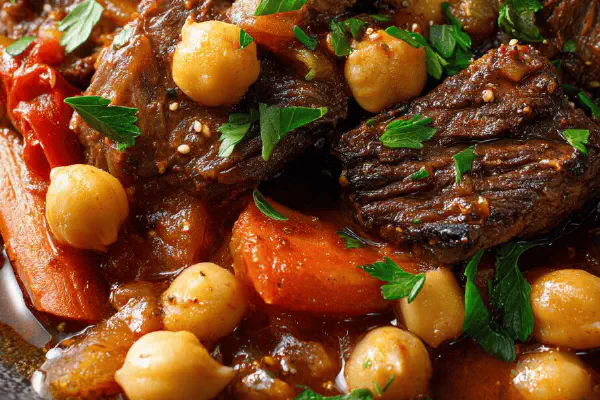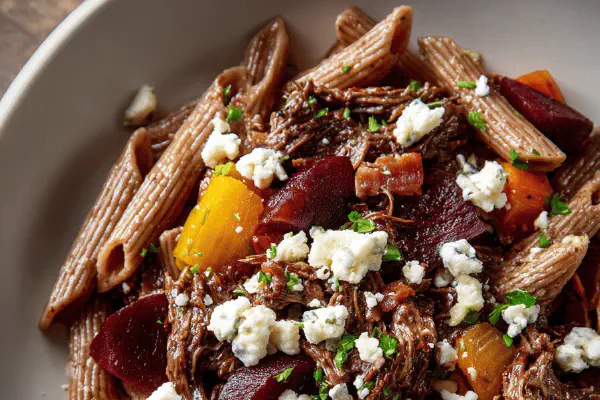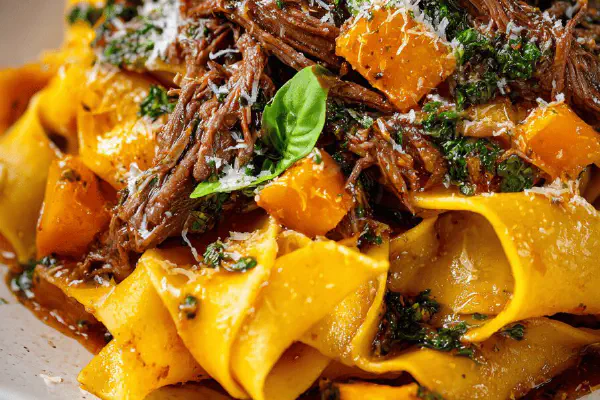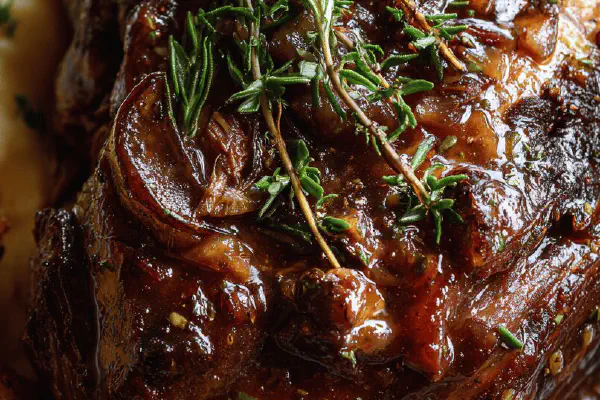Braised Beef with Peppers and Cherry Tomatoes
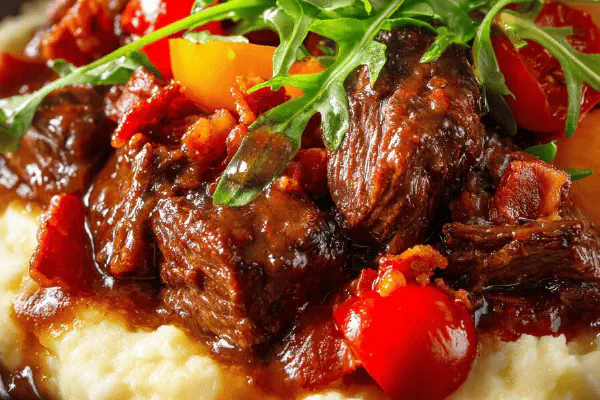
By Emma
Certified Culinary Professional
Ingredients
- 1.1 kg boneless beef chuck roast, cut into 4 chunks
- 25 ml olive oil
- 100 g smoked bacon, diced (instead of pancetta)
- 2 large onions, chopped
- 2 bell peppers (red or yellow), seeded and diced
- 8 garlic cloves, minced
- 400 ml dry white wine
- 400 ml chicken broth
- 450 ml mixed red and yellow cherry tomatoes
- Arugula to garnish
- Salt and freshly ground black pepper
About the ingredients
Method
- Arrange oven rack mid-level; preheat to 175 °C (350 °F).
- Heat olive oil in a heavy ovenproof pot over medium-high. Brown beef pieces well, turn till deep color forms. Season with salt and pepper. Remove meat, rest on plate.
- Leave rendered fat. Add diced bacon; crisp until fat releases and edges turn golden. Toss in onions, peppers, and garlic. Sweat gently until onions soften, about 8 minutes. Avoid browning these too much; we want sweetness.
- Nestle beef back in pot. Pour in wine and broth; bring liquid to a simmer on stove. Scrape bottom to lift any stuck bits—this builds flavor.
- Cover pot tightly. Transfer to oven. Braise for approx 1 hr, check liquid occasionally. If evaporating too fast, add a splash of broth.
- After hour one, add cherry tomatoes. Meat should start getting tender but not falling apart yet. Return covered to oven, continue braising about 55–65 minutes more. Check with fork; meat should break slightly but not turn mush.
- Remove lid last 30 minutes. This step thickens sauce and intensifies aroma—listen for gentle boil and watch liquids reduce to velvety consistency.
- Lift meat out; rest covered. Set pot on stove over medium heat. Reduce sauce more as needed, stirring occasionally. Adjust seasoning with salt and pepper. Should coat spoon thickly but still pour.
- Serve beef on creamy mashed potatoes or root veg mash. Spoon sauce over generously. Garnish with fresh arugula for bite and peppery contrast. The greens add lift to dense, braised flavors.
- Tips: If you only have regular bacon, expect smokier notes. For wine, dry white works best—a fruity but crisp character helps balance richness here. Chicken broth can be swapped for beef stock but keep salt in check.
- Watch meat closely near end—overcooking makes it stringy; undercooking leaves tough patches. Use fork stiffness as guide, not just time.
Cooking tips
Chef's notes
- 💡 Brown meat well. Don’t rush. That crust forms flavor base. Keep heat moderate-high, listen for steady sizzle not burning. Flip often. Rest meat before next step; retains juices.
- 💡 Use smoked bacon not pancetta? Expect smokier notes. Crisp bacon fat well, but avoid bitter burnt bits. Render fat slowly. Toss veggies gently, sweat till soft but never brown. Sweetness depends on patient softening.
- 💡 Don’t skip scraping pot after liquids go in. That stuck stuff at bottom—flavor booster. Stir to loosen bits before braise. Keeps sauce complex, not flat. Add broth sparingly if evaporation too quick, watch eye and nose cues.
- 💡 Tomatoes go late in braise—fresh bursts, not mush. Wait till meat tender but intact. Lid off last half hour thickens sauce, catch gentle boil sounds; too loud means scorch risk. Stir carefully, sauce thickness should coat spoon but still pour.
- 💡 Watch fork stiffness near end. Meat should yield with slight resistance. Overcooked equals stringy; undercooked tough. Rest covered meat after braise; redistribute juices. Arugula garnish cuts fat, brings green sharpness needed for heavy stew.
Common questions
Can pancetta be swapped with bacon?
Yes but smoky bacon changes profile. Crisp fat slower, watch salt. Pancetta softer, less smoky. More salt control needed with bacon. Try both once; different textures each.
How to know if beef is done braising?
Fork test best. Meat breaks slightly not mush. Jiggle pieces to check softness. Time varies by chunk size, oven temp. If too tough, add broth, cover, more time. Too stringy? Overcooked easy here.
Can I use beef stock instead of chicken broth?
Sure but beef stock more intense. Reduce added salt if stock rich. Chicken broth lighter, lets wine shine more. Beef stock adds body but hits salt faster. Taste test always after reduction.
Best way to store leftovers?
In airtight container fridge up to 3 days works. Sauce thickens cold, reheat gently, add splash broth to loosen. Can freeze; thaw slowly in fridge overnight. Reheat on stovetop best to preserve texture.
